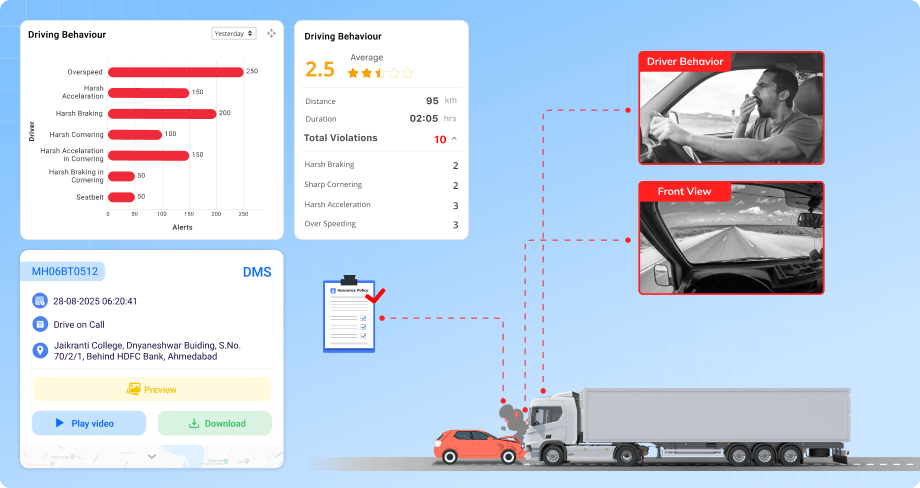Enhancing fleet safety across the U.S. through video telematics
Introduction
Across the United States, fleet operators are under growing pressure to reduce accident-related losses, comply with safety mandates, and protect their assets on the road. In regions like Texas where long-distance trucking plays a crucial role in the economy, these challenges become even more complex. With vast highways, cross-border cargo movement, and increasing liability claims, fleet managers are turning to video telematics to gain better visibility and control. From nationwide carriers to regional transport companies, AI-powered dashcams are now seen as a critical tool for monitoring driver behavior, resolving disputes, and improving on-road safety.
Challenges
- No video proof during accident investigations: A Texas-based logistics company recently faced a lawsuit after a collision on a rural highway. With no footage to support the driver’s account, the company had to settle despite doubts about who was at fault. Many fleets struggle with similar situations where lack of video evidence leaves them vulnerable to false claims and costly settlements.
- Unsafe driving behavior during long-haul trips goes undetected: On a cross-border route from Laredo to Dallas, a fleet manager noticed recurring brake issues but couldn’t link them to any specific driver. Later, it was found that one driver frequently engaged in harsh braking and rapid acceleration – but only after a dashcam was installed. Without real-time monitoring, unsafe habits often stay hidden until serious damage occurs.
- Insurance premiums keep rising due to unverified driver conduct: In Houston, a delivery fleet saw its insurance rates spike after multiple minor accidents. Most incidents lacked witnesses or proof, making it difficult to defend drivers. Insurance providers considered the fleet high-risk simply due to lack of evidence, not actual performance.
- Night-time and rural operations lack visibility: Fleets covering remote areas in West Texas often run overnight, where poor lighting and long distances reduce oversight. In one case, a driver made an unscheduled stop in a no-network zone, leading to a damaged trailer and delayed delivery. Without video and GPS sync, there was no way to assess what really happened.
Solution
- Dashcam integration with live streaming and playback: The software allows fleet managers to access live video from any vehicle, anywhere in the country. Whether it’s a highway crash or a suspicious stop, real-time footage and playback help verify the facts and respond immediately.
- AI-based behavior detection for proactive alerts: Using built-in AI, the system detects risky behavior like phone use, fatigue, or drowsiness. Instant alerts are sent to the fleet dashboard, allowing timely feedback and reducing the chance of an accident during long-distance routes.
- Event-triggered video logging for easier reviews: When harsh events occur, such as hard braking, rapid turns, or collision-like force, the system automatically captures the image. Managers can quickly retrieve and review incidents without scanning through hours of footage.
- Driver-wise safety scoring and violation history: The platform assigns a performance score to each driver based on their behavior patterns. Fleets can identify unsafe drivers early and provide targeted training or corrective action, all without manual tracking.
- Fatigue, distraction, and safety compliance detection using integrated tools: With support from Driver Monitoring Systems, the software identifies fatigue, mobile phone usage, and seatbelt non-compliance. It also detects aggressive maneuvers like harsh cornering through integrated safety systems, helping prevent accidents before they happen.
- Footage backup for incident resolution: Every video clip is backed up with time, location, and incident type and is saved in the memory card. This helps in organizing visual evidence for future use in claim settlement, driver disputes, or internal audits, especially helpful for remote or rural trips.
Results
- Reduced accident-related expenses by up to 30%: With real-time alerts and recorded footage, fleets are able to prevent incidents and defend against false claims. This leads to lower legal costs and fewer insurance payouts.
- Improved driver performance across regional and national fleets: Drivers become more accountable when they know their actions are being monitored. Over time, this leads to better habits, safer driving, and fewer violations during long-haul trips.
- Faster resolution of disputes and claims: In case of an incident, having clear video evidence helps close investigations quickly. Whether dealing with insurers, clients, or law enforcement, fleets save valuable time and avoid prolonged disruptions.




